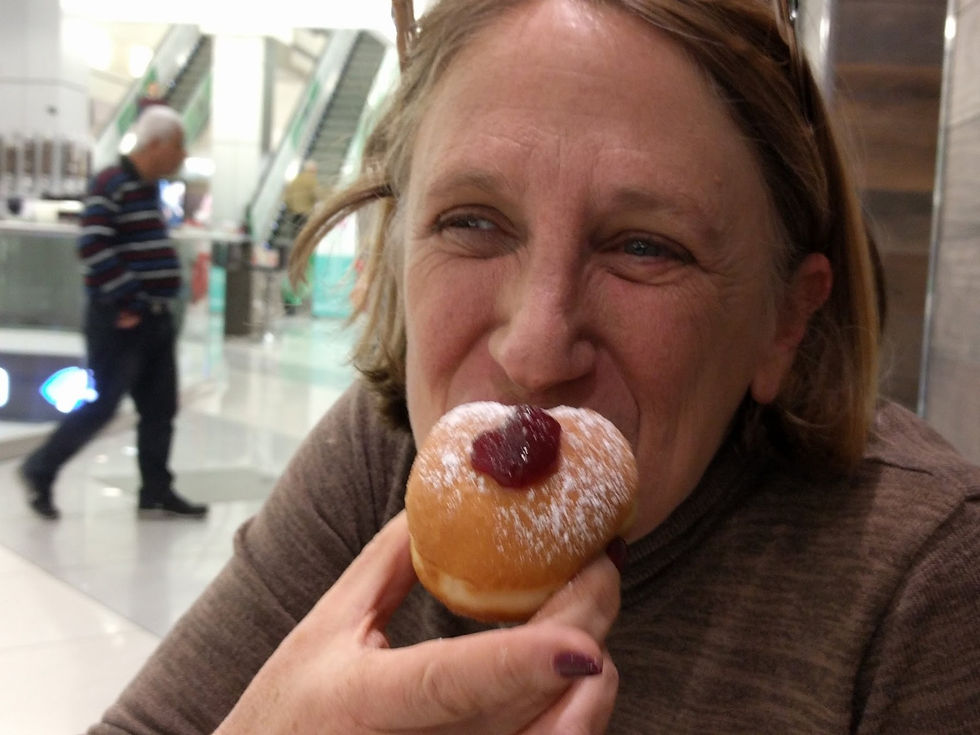Chanukah: The Spiritual and the Spectacular
- Onnie Schiffmiller
- Nov 14, 2021
- 3 min read

Chanukah in Israel
This year the holiday of Chanukah begins on Sunday night, 28th November and continues on through to Monday night, 6th December. Along with a candle-lighting ceremony each of the eight nights of Chanukah, there are also a variety of delicacies are prepared in oil (see the reason below **) one of our favorites in Israel are sufganiyot or fried donuts.
Favorite delicacies

These extravaganzas of fried dough with fillings and toppings of every kind are found EVERYWHERE from humble local grocery stores selling simple donuts with strawberry filling to high-end bakeries selling donuts with alcohol-infused fillings and even gold shavings, chocolate ganache or crème fraiche!
The time-honored symbols of Chanukah - chanukiot or Chanukah menorahs and dreidels can be found in nearly every store and made of anything from simple plastic or ceramic to sterling silver. But, as much as we love the lights, aromas and tastes of the holiday, what’s really behind all of the celebration?

The Chanukah story
Israel is Beautiful is here to offer you a quick summary of the Chanukah story.
The Seleucid Greeks ruled in Judea in 200 BCE.
King Antiochus outlawed Jewish practice and defiled the Temple. He installed an altar to Zeus and brought pigs into the Temple.
Meanwhile, a small group of Jews known as the Maccabees, banded together to overthrow the Greeks and restore the Temple.
Though small in number, the Maccabees overthrow the Greeks and rededicate the Temple.
The challenge: When the Maccabees entered the Temple, tradition states that they only found one cruse of oil. Miraculously, the one cruse lasted eight days. ** It is this tradition that makes oil, specifically olive oil, and all of the delicious treats fried in olive oil so central to the holiday celebrations throughout the ages. We love eating latkes (levivot in Hebrew), sufganiyot and other fried delicacies – the more oil, the better!
The Maccabees evolved into the Jewish Hasmonean dynasty which ruled Israel for 100 years.
The chanukiah or Chanukah menorah that we light during the holiday is different than the Temple menorah. The menorah that stood in the Temple had SEVEN branches, while the chanukiah that we used during Chanukah has EIGHT branches to commemorate the miracle that lasted eight days!
Traditionally, we play a game with a dreidel (top) or sevivon in Hebrew. In Israel, the four-sided sevivon has four letters, one on each side: NUN, GIMEL, HEH, PEY; which stands for the verse “Nes Gadol Haya Po” (A Great Miracle Happened HERE). Outside of Israel, the dreidel displays four letters, but the last letter is SHIN instead of PEY; this is because outside of Israel, the saying is “Nes Gadol Haya Sham” – A Great Miracle Happened THERE.

Will you be celebrating Chanukah in Israel? If you are, Israel with Love has some great suggestions for you!
Cheer on the runners during the annual Torch Relay from Modiin (between Tel Aviv and Jerusalem) where many of the Maccabees lived) where the torch is handed from runner to runner and culminating with the lighting of the chanukiah at the Kotel (Western Wall).
Visit the Ein Yael Museum in Jerusalem and make olive oil the old-fashioned way.
Visit the Hasmonean Village in Shilat near Modiin.
Visit the Israel Museum or Beit Guvrin National Park to see remains from the Hasmonean Dynasty.
Next week, Israel is Beautiful will share some of our favorite places to buy sufganiyot and even a latke recipe for you to enjoy with your family!
About Israel is Beautiful
We offer exciting virtual tour subscription packages (weekly virtual tours, downloadable activity sheets and LIVE ‘meet the tour guide’ ZOOM chats) to individuals, synagogues/shuls and church groups, Sunday school groups and educational programs. Our magical virtual tours await you! Subscribe here: https://www.israelisbeautiful.com/about-subscriptions







Comments